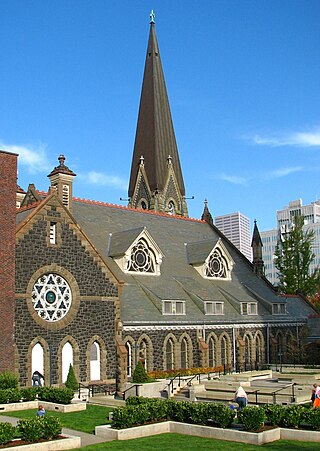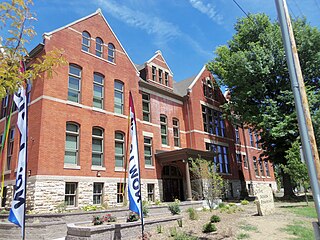
Ralph Adams Cram was a prolific and influential American architect of collegiate and ecclesiastical buildings, often in the Gothic Revival style. Cram & Ferguson and Cram, Goodhue & Ferguson are partnerships in which he worked. Cram was a fellow of the American Institute of Architects.

Wick Park Historic District is a historic neighborhood on the north side of Youngstown, Ohio, with Wick Park as its centerpiece. During the first half of the 20th century, the residential district surrounding Wick Park included some of the city's most affluent neighborhoods. The district is "roughly bounded by 5th Ave, Park Ave, Elm St. and Broadway".

The Andrews Memorial Chapel is a historic Carpenter Gothic-style former Presbyterian church building now located in Dunedin, Florida. It was built in 1888 as the Andrews Memorial Church on the corner of Scotland Street and Highland Avenue. Its name was carried over from an 1871 Presbyterian church located where the Dunedin Cemetery is now and commemorates William Andrews, son of John G. Andrews, who "died while riding a horse in a violent storm." The church is located next to Hammock Park.

The First Presbyterian Church of Golden and the Unger House are two buildings in the Foothills Art Center in Golden, Colorado, United States. Together with a manse adjourning the church they were listed on the National Register of Historic Places in 1991, and are the most prominent landmarks of Golden's Court House Hill neighborhood.
William Wick was Presbyterian Minister and schoolmaster in the frontier of Washington County, Pennsylvania, and the Connecticut Western Reserve in Ohio. His son, William W. Wick was a U.S. Representative from Indiana and Secretary of State of Indiana.

Pilgrim Presbyterian Church is a historic church building in the Mount Adams neighborhood of Cincinnati, Ohio, United States, near the Ida Street Viaduct. Built in 1886, it is a Gothic Revival structure built primarily of brick. Constructed by Mount Adams architect and builder Charles E. Iliff, the church features a two-story rectangular floor plan with a prominent central bell tower. Among its other distinctive architectural elements are the rose windows in the main gable, pairs of windows on its second floor, and the symmetry evidenced in the overall design of the building.

Armstrong Chapel United Methodist Church is a historic church in the city of Indian Hill, Ohio, United States. Built in 1831, it is a small rectangular building with a prominent front tower. It was designated a historic site in 1975.

Walnut Hills United Presbyterian Church is a historic church tower in the Walnut Hills neighborhood of Cincinnati, Ohio, United States. The last remnant of a landmark church building, it was designed by a leading Cincinnati architect and built in the 1880s. Although named a historic site a century after its construction, the building was mostly destroyed after extensive neglect caused restoration to become prohibitively expensive.

The Symmes Mission Chapel was a historic church building in the city of Fairfield, Ohio, United States. A simple structure constructed in the 1840s, it was named a historic site in the 1980s, but it is no longer standing.

Charles Henry Owsley (1846–1935) was an English-born American architect in practice in Youngstown, Ohio from 1872 until 1912.

The Sea and Land Church is located at 61 Henry Street and Market Street in the Chinatown and Two Bridges neighborhoods of Manhattan in New York City. It was built in 1819 of Manhattan schist, and added to the National Register of Historic Places on April 9, 1980. The structure is one of the three Georgian Gothic Revival churches on the Lower East Side with the other ones being St. Augustine's Chapel and the Church of the Transfiguration. It is also the second oldest church building in New York City.

The Circular Congregational Church is a historic church building at 150 Meeting Street in Charleston, South Carolina, used by a congregation established in 1681. Its parish house, the Parish House of the Circular Congregational Church, is a highly significant Greek Revival architectural work by Robert Mills and is recognized as a U.S. National Historic Landmark.

The Orleans County Courthouse Historic District is one of two located in downtown Albion, New York, United States. Centered on Courthouse Square, it includes many significant buildings in the village, such as its post office and churches from seven different denominations, one of which is the tallest structure in the county. Many buildings are the work of local architect William V.N. Barlow, with contributions from Solon Spencer Beman and Andrew Jackson Warner. They run the range of architectural styles from the era in which the district developed, from Federal to Colonial Revival.

First Presbyterian Church Complex, also known as United Presbyterian Church, is a historic Presbyterian church located at Cortland in Cortland County, New York. It was built in 1889-1890 and is a solid massed masonry building consisting of a central hip-roofed main block fronted by steeply pitched gable projections. Major additions to the original church were completed in 1922 and 1958. The church features a stout, multi stage bell tower with a tall steeple and prominent cross on the spire. Also on the property is a Queen Anne style manse completed in 1903.

The Ashland Commercial Historic District is a designated historic district bounded by 13th Street, Carter Avenue, 18th Street, and Front Street in Downtown Ashland, Kentucky. It is composed of 84 properties, including such prominent buildings as the Camayo Arcade, Crump and Field Grocery Company, First Presbyterian Church, Paramount Arts Center, and Ashland National Bank Building.

The First Presbyterian Church is a church building located in downtown Portland, Oregon, that is listed on the National Register of Historic Places. Construction began in 1886 and was completed in 1890. The building has been called "one of the finest examples" of High Victorian Gothic architecture in the state of Oregon. It includes stained-glass windows made by Portland's Povey Brothers Art Glass Works and a church bell cast with bronze from captured Civil War cannons.

School Number 6, also known as Jackson School and Holy Family School, is an historic building located in Davenport, Iowa, United States. It was listed on the Davenport Register of Historic Properties and on the National Register of Historic Places in 2011.

The Welsh Congregational Church was a historic church in Youngstown, Ohio, United States. Formed by some of Youngstown's large Welsh American community, it was once the center of Welsh life in Youngstown, and it has been designated a historic site. Despite efforts to preserve the church, the Catholic Diocese of Youngstown demolished it on April 28, 2022 after decades of abandonment.

The Weybridge United Reformed Church situate at Queen's Road, Weybridge, near to its junction with York Road, is a Victorian Grade II Listed church building that is now no longer used as a place of worship.

Truman I. Lacey (1834–1914) was an American architect in practice in Binghamton, New York from 1872 until 1914.





















